
TUAT's competitive research program "TAMAGO" in FY2018
Tokyo University of Agriculture and Technology (TUAT) in Japan is a science research university that navigates the future through innovation by state-of-the-art science and technology. Under the President's vision for the medium-term goals and plans (FY2016 to FY2021), TUAT strives to strategically strengthen its leading role by “building a world-class research university”. Toward this goal, a new internal competitive research program, called TAMAGO*, was implemented in FY2018. TAMAGO facilitates the creation and nurturing of interdisciplinary research teams that challenge existing paradigms and tackle unsolved scientific issues. Each team comprises top-notch researchers from both the Institute of Agriculture and the Institute of Engineering at TUAT. The team’s research efforts will ultimately lead to the core of open innovation at TUAT.
*: TAMAGO (meaning “egg” in Japanese), Technologically Advanced Research through Marriage of Agriculture and Engineering as Groundbreaking Organization.
Research Projects funded by TAMAGO in FY2018
Plant “Symbiosis” Batteries with Efficient Power Generation/Storage
Plant “Symbiosis” Batteries with Efficient Power Generation/Storage
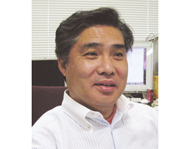
The team head: Katsuhiko Naoi, Ph.D. Professor, Division of Applied Chemistry, Institute of Engineering.
This interdisciplinary project is ultimately aimed for the establishment of plant batteries with “double harvest system”, which enable both the symbiosis of plants and power generation. Plant environment generates electricity through the decomposition of photosynthesized organic compounds via electrochemically active microorganisms (bacteria) in the soil system. This is, in other words, a transformation of photoenergy (sunlight) into chemical energy (organic compounds), and then electrical energy (electricity). The generated electricity by the plant environment is, however, too feeble to be captured/stored in conventional batteries.
Our cooperative research team will tackle the issues from the different research perspectives ;
-
Horticultural Science : maximization of plant photosynthesis ability by plants selection, companion planting, and improvement in the plants cultivation methods.
-
Soil Microbiology : investigation of microbial community for the highly-efficient power generation and current collection in the soil.
- Energy Materials / Capacitor Science : establishment of efficient energy storage system which enables a storage of the generated feeble current by designing new types of electrodes and combining different capacitors.

The team members :
Naoko Ohtsu, Ph.D. Professor | Division of Science of Biological Production | Institute of Agriculture and Institute of Global Innovation Research
Shin Okazaki, Ph.D. Professor | Division of International Environmental and Agricultural Science | Institute of Agriculture
Wako Naoi, CEO | K&W Inc.
Naohisa Okita, Ph.D. Assistant Professor | Division of Applied Chemistry | Institute of Engineering
Etsuro Iwama, Ph.D. Associate Professor | Division of Applied Chemistry | Institute of Engineering
Kun Yuan, Ph.D. Assistant Professor | Institute of Global Innovation Research
Reid McMahon, Ph.D. Visiting Associate Professor | Department of Mathematics | MIT
Kenji Tamamitsu, Executive Officer | NIPPON CHEMI-CON CORPORATION
Junichi Miyamoto | NIPPON CHEMI-CON CORPORATION
Tadashi Yokoyama, Ph.D. Emeritus Professor
Comprehensive solution for microplastic pollution through interdisciplinary research in agriculture and engineering
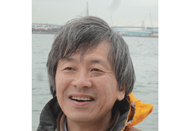
The team head: Hideshige Takada, Ph.D. Professor, Division of Environmental Science on Biosphere, Institute of Agriculture.
The research team, comprised of 5 top-notch scientists in Agriculture and Engineering at TUAT, aims to be first to solve the social concern caused by microplastic pollution. The team’s outstanding state-of-the-art research will continue to provide a deeper understanding of the environmental distribution of microplastics and their harmful impact on living organisms. The team will work at reducing the risks of microplastics by developing new technology and materials based on Life Cycle Assessment (LCA). In addition, it plans to establish a research center by expanding this interdisciplinary research. The team’s ultimate goal is to contribute to a sustainable development in harmony with the global environment.
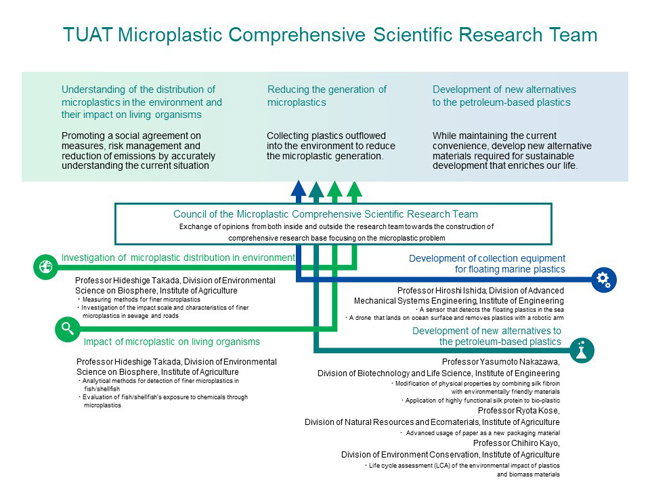
The team members :
Ryota Kose, Ph.D. Senior Assistant Professor | Division of Environmental Science on Biosphere | Institute of Agriculture
Hiroshi Ishida, Ph.D. Professor | Division of Advanced Mechanical Systems Engineering | Institute of Engineering
Yasumoto Nakazawa, Ph.D. Associate Professor | Division of Biotechnology and Life Science | Institute of Engineering
Chihiro Kayo, Ph.D. Associate Professor | Division of Environment Conservation | Institute of Agriculture
More information
Plastic Pollution: http://www.pelletwatch.org
Development of nutrient up-cycling technology from wastewaters and wastes by an interdisciplinary approach in both agriculture and engineering
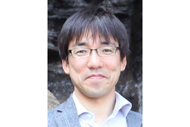
The team head: Akihiko Terada, Ph.D. Professor, Division of Applied Chemistry, Institute of Engineering.
Now is the time when wastewater discharged from both human and industrial activities is called “Resource Water” or “Enriched Water” They are thus considered as resource and energy that should be recovered. In the water treatment field, there is a paradigm shift in the development of technology from pollutant removal to the recovery of resources and energy. Innovation is, therefore, required to efficiently capture resources from wastewaters and solid wastes. The interdisciplinary research aims at developing new recovery technologies from nitrogen and phosphorus compounds, which cause eutrophication and water pollution. The overarching goal of this team is to explore new microorganisms turning these materials into valuable products, to harness them, and to build a recovery technology platform towards a new nitrogen management system.
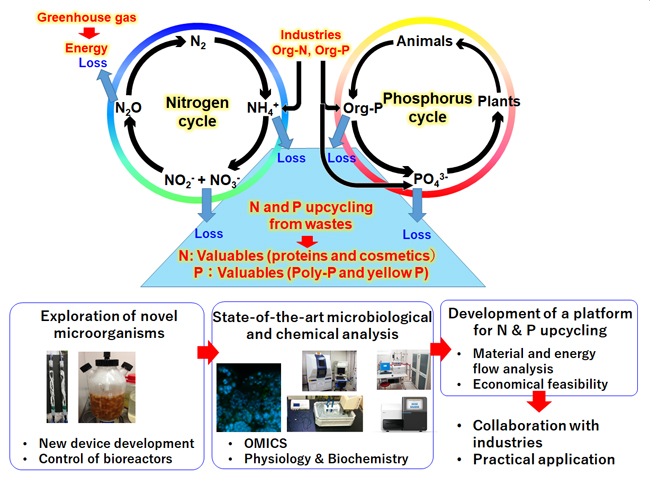
The team members :
Yohey Hashimoto, Ph.D. Associate Professor | Division of Sciences for Biological System | Institute of Agriculture
Shohei Riya, Ph.D. Associate Professor | Division of Applied Chemistry | Institute of Engineering
More Information
Suenaga et al., Enrichment, Isolation, and Characterization of High-Affinity
N2O-Reducing Bacteria in a Gas-Permeable Membrane Reactor
Environmental Science & Technology (2019), 53: 12101-12112
DOI: 10.1021/acs.est.9b02237
Terada et al., Hybrid Nitrous Oxide Production from a Partial Nitrifying Bioreactor: Hydroxylamine Interactions with Nitrite
Environmental Science & Technology (2017), 51: 2748-2756
DOI: 10.1021/acs.est.6b05521
Hashimoto et al., Formations of Hydroxyapatite and Inositol Hexakisphosphate in Poultry Litter during the Composting Period: Sequential Fractionation, P K-edge XANES and Solution 31P NMR Investigations
Environmental Science & Technology (2014), 48: 5486-5492
DOI: 10.1021/es404875j
Contact
Research Promotion Office
E-mail: wakate[at]cc.tuat.ac.jp (Please replace [at] with @.)

